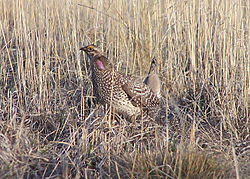- Columbian Sharp-tailed Grouse
-
Columbian Sharp-tailed Grouse 
Conservation status Scientific classification Kingdom: Animalia Phylum: Chordata Class: Aves Order: Galliformes Family: Phasianidae Subfamily: Tetraoninae Genus: Tympanuchus Species: Tympanuchus phasianellus Subspecies: T. p. columbianus Binomial name Tympanuchus phasianellus columbianus
(Linnaeus, 1758)The Columbian Sharp-tailed Grouse (Tympanuchus phasianellus columbianus) is a subspecies of Sharp-tailed Grouse native to the Western United States and British Columbia.
Contents
Description
Out of the seven subspecies of Sharp-tailed Grouse, the Columbian is the smallest at 15–20 inches (38–51 cm) in length.[1] They have plumage with a base of grayish-brown, white and black markings, and a white wedge-shaped tail. Males have a longer tail, a purple throat patch and a yellow comb over the eye.
Distribution and habitat
Its historical range extended from British Columbia south through eastern Washington and Oregon to Northeastern California, Nevada, and Utah, and then west to the Continental Divide.[2] It inhabits sagebrush-bunchgrass prairies, meadow-steppe, mountain shrub, and riparian zones. It was first described by the Lewis and Clark expedition,[3] and was named by George Ord.[4]
Status and conservation
Due to excessive hunting and habitat loss, it is no longer present in the majority of its range, and exists only in isolated remnant populations that comprise less than ten percent of its original habitat.[4] These populations are sequestered in central British Columbia, southeastern Idaho and northern Utah, and northwestern Colorado and south-central Wyoming.[4] It was extirpated entirely from Oregon by the 1960s, but was reintroduced in Wallowa County beginning in 1991;[5] a small population of the birds now persists in the Leap Area of Zumwalt Prairie.[6]
The Columbian Sharp-tailed Grouse was petitioned to be listed as Threatened under the Endangered Species Act twice, but was denied in both cases.[4][7] It is currently considered a Species of Concern in several U.S. states.[4][7]
See also
References
- ^ "Columbian Sharp-tailed Grouse Q&A". U.S. Fish and Wildlife Service. http://www.fws.gov/pacific/news/2000/2000-166qa.htm. Retrieved 2008-12-26.
- ^ Warheit, Dr. Kenneth I.; Dr. Michael A. Schroeder (July 2001). "Genetic Analysis of Columbian Sharp-Tailed Grouse: A Preliminary Study - Final Report". wdfw.wa.gov. Washington Department of Fish & Wildlife. http://wdfw.wa.gov/wlm/research/papers/sharptail_grouse/sharptail_genetics.htm. Retrieved 2008-12-26.[dead link]
- ^ "Lewis & Clark-Animals-Columbian Sharp-tailed Grouse". nationalgeographic.com. enature.com. http://www.nationalgeographic.com/lewisandclark/record_species_193_15_4.html. Retrieved 2008-12-26.
- ^ a b c d e Hoffman, Richard W.; Allan E. Thomas (August 17, 2007). "Columbian Sharp-tailed Grouse (Tympanuchus phasianellus columbianus): A Technical Conservation Assessment". fs.fed.us. U.S. Forest Service. http://www.fs.fed.us/r2/projects/scp/assessments/columbiansharptailedgrouse.pdf.
- ^ "Upland Game Birds - Re-introuducing Columbia sharp-tailed grouse". dfw.state.or.us. Oregon Department of Fish & Wildlife. http://www.dfw.state.or.us/resources/hunting/upland_bird/projects/index.asp. Retrieved 2008-12-27.
- ^ Cockle, Richard (Friday, August 20, 2010). "Zumwalt Prairie undergoes changes as the Nature Conservancy works to protect natural environment". The Oregonian. http://www.oregonlive.com/environment/index.ssf/2010/08/zumwalt_prairie_undergoes_chan.html.
- ^ a b "Columbian Sharp-tailed Grouse". Species Fact Sheet. Oregon Department of Fish & Wildlife. http://www.fws.gov/oregonfwo/Species/Data/ColumbianSharptailedGrouse/. Retrieved 2008-12-26.
External links
- video from Oregon Field Guide about reintroduction efforts in the state
Categories:- IUCN Red List least concern species
- Tympanuchus
- Grouse
- Native birds of the Western United States
- Galliformes stubs
Wikimedia Foundation. 2010.

